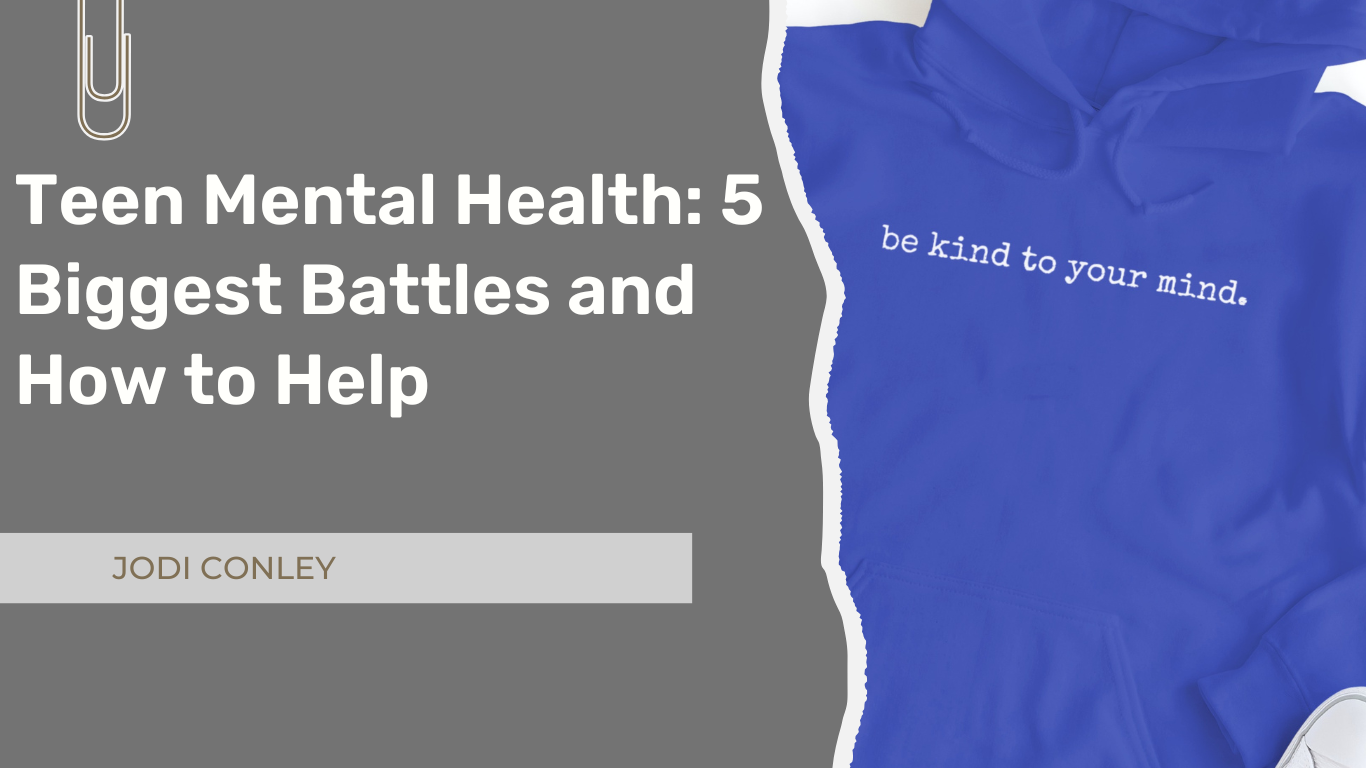Teen mental health issues have increased significantly in recent years. According to the National Institute of Mental Health in 2021, nearly 49.5% of adolescents had a diagnosable mental health disorder at some point in their life. Depression and anxiety are among the most common issues faced by this demographic. The historical stigmatization of mental health has slowly begun to lessen, allowing for more discussion around these topics. However, significant barriers remain. Adolescents often feel isolated in their struggles, exacerbated by societal pressures and the nature of social media. Let’s discuss the top five mental health struggles of adolescents, highlighting statistics, and offering solutions to help.
1. ANXIETY
One of the most prevalent mental health struggles facing adolescents is anxiety disorders. According to the National Institute of Mental Health, approximately 31.9% of adolescents aged 13 to 18 have an anxiety disorder. This statistic highlights the importance of recognizing anxiety not merely as stress but as a serious mental health condition. Factors contributing to anxiety in adolescents include academic pressure, social dynamics, and exposure to technology. For instance, the rise of social media has intensified feelings of inadequacy and anxiety. Adolescents facing these issues often benefit from cognitive-behavioral therapy, which enables them to identify and alter negative thought patterns. Schools can implement programs that encourage open discussions about mental health to help students voice their concerns.
2. DEPRESSION
Another major concern is depression, which affects around 13% of adolescents aged 12 to 17 according to the Substance Abuse and Mental Health Services Administration. This condition can escalate quickly and lead to detrimental effects on both academic performance and social relationships. Factors contributing to adolescent depression include familial issues, peer pressure, and academic challenges. The impacts can be severe, as young individuals may face debilitating sadness and lethargy, which can lead to poorer quality of life. Support mechanisms such as peer mentoring programs can help mitigate the effects of depression. Schools can facilitate workshops aimed at fostering emotional intelligence and coping skills, allowing adolescents to navigate their feelings more effectively.
3. EATING DISORDERS
Eating disorders are another significant mental health struggle impacting adolescents. The National Eating Disorders Association reports that around 10 million females and 1 million males in the United States will experience a clinically significant eating disorder at some point in their lives. Bulimia and anorexia nervosa are particularly common during adolescence, a critical period for body image development. The media’s portrayal of ideal body types can exacerbate feelings of inadequacy, leading to harmful behaviors such as binge eating or restrictive dieting. Awareness campaigns and education on healthy eating habits can prevent the onset of these disorders. Parents and educators should encourage body positivity and facilitate communication about self-image. Creating a supportive environment reduces stigma and promotes healthier behavior.
4. ADHD
Attention-Deficit/Hyperactivity Disorder (ADHD) is another mental health challenge many adolescents face. The Centers for Disease Control and Prevention highlight that about 9.4% of children between the ages of 2 and 17 have been diagnosed with ADHD. Symptoms often overlap with common adolescent behavior, leading to underdiagnosis or misdiagnosis. Adolescents with ADHD may struggle with social interactions and academic achievement due to difficulties in concentration and organization. Positive reinforcement, structured routines, and behavioral interventions can help adolescents manage their symptoms. Collaboration between parents, teachers, and mental health professionals is essential in creating a tailored plan that addresses each adolescent’s unique needs.
5. SELF-HARM
Self-harm is an increasingly recognized issue among adolescents. Studies indicate that around 17% of adolescents have engaged in self-harm at some point. This troubling statistic suggests that many young people resort to self-injury as a coping mechanism for emotional distress. Factors that lead to self-harm include feelings of hopelessness, trauma, and social isolation. Early intervention is crucial in addressing the underlying issues related to self-harm. Mental health professionals should adopt a non-judgmental approach when working with adolescents. Supportive therapies, including dialectical behavior therapy, have shown promise in helping adolescents develop healthier coping strategies.
What Helps Teen Mental Health?
Family dynamics play a crucial role in adolescent mental health. Supportive family environments can foster resilience and promote positive mental health. Conversely, exposure to conflict, neglect, or trauma can lead to severe mental health challenges. The importance of open communication within families cannot be overstated. Adolescents need to feel safe discussing their feelings and experiences. Programs and initiatives that educate families on mental health awareness can bridge gaps in understanding and create healthier home environments.
Schools are a critical setting for early intervention and prevention. Mental health education is increasingly being integrated into school curriculums. This initiative is vital for reducing stigma and encouraging help-seeking behavior. Programs like Mental Health First Aid train school staff to recognize signs of mental health struggles and provide appropriate responses. Furthermore, implementing counseling services within schools makes it easier for students to access support.
Influential individuals have made significant contributions to the field of teen mental health. Figures such as Dr. Nadine Burke Harris advocate for understanding the effects of adverse childhood experiences on mental health. Her work has shed light on how trauma during crucial developmental stages can lead to long-term mental health issues. Such advocacy plays a formative role in shifting societal perceptions towards mental health.
Beyond individual interventions, there is a growing recognition of the need for systemic change. Policy reforms focused on mental health funding, access to care, and integrating mental health services with primary healthcare are essential. The World Health Organization emphasizes that investing in mental health is a smart economic decision, as it improves overall community health and productivity. Ensuring access to affordable mental health care for adolescents is essential for the overall health of communities.
What Lies Ahead with Teen Mental Health?
Future developments in the realm of adolescent mental health may revolve around technology and innovative therapies. Teletherapy and mobile mental health applications are becoming more mainstream. These tools provide accessible support for adolescents in various settings. Additionally, there is a growing body of research exploring the efficacy of virtual reality in treating conditions like anxiety and PTSD. Such advancements could revolutionize how mental health care is delivered, making it not only more accessible but also more appealing to tech-savvy young people.
Teen Mental Health Must Be Addressed
There are numerous teen mental health challenges, including anxiety disorders, depression, eating disorders, ADHD, and self-harm. The implications of these issues are serious, affecting the emotional and psychological well-being of young individuals. It is essential to foster supportive and communicative environments both at home and in schools. By increasing awareness and understanding of these disorders, we can create a culture where adolescents feel safe and supported in discussing their struggles. Through proactive measures, we can work towards a future where these mental health challenges are addressed effectively, allowing adolescents to thrive.

